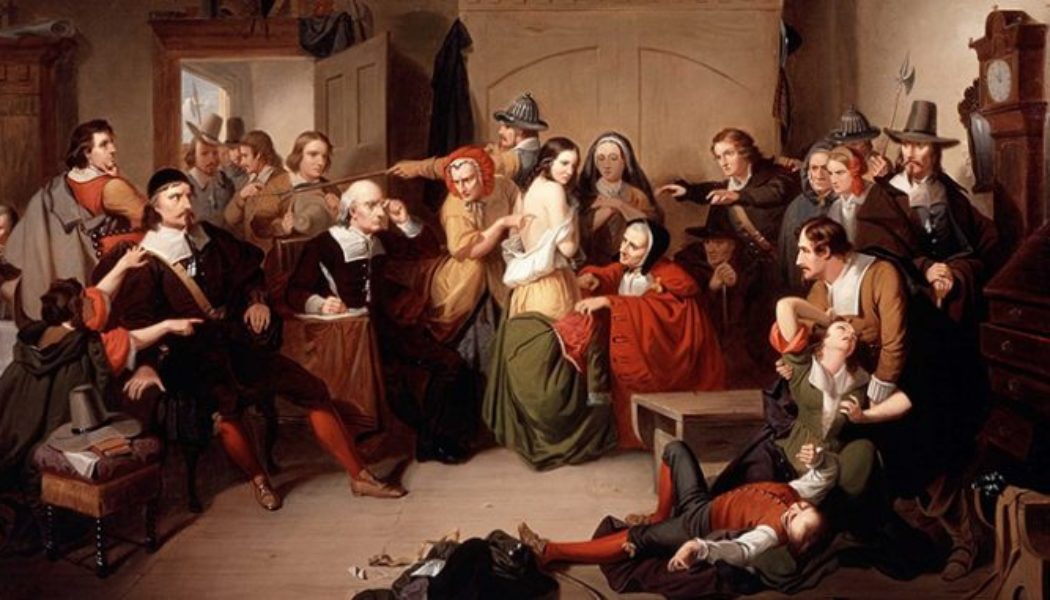
For the last couple of years, J.K. Rowling has been the victim of a witch hunt. The author of the Harry Potter series has been harassed, hounded, shouted down, and targeted with numerous death threats.
Rowling is not being hunted down by church folks with pitchforks. Instead, the woman who did more to popularize witches and wizards than anyone in history is being persecuted by young people, many of whom are former fans.
She is being hounded not for having gone too far down the path of fantasy, but for not having gone far enough. Her major sin is her refusal to go along with the LGBTQ+ fantasy that boys can become girls, girls can become boys, men can become pregnant, and so forth.
She is being persecuted for having drawn a line between fiction and reality.
The Rowling affair serves to remind us that sometimes the victims of witch hunts are not those who identify as witches, but those who deny the existence of witches—those who won’t go along with the fantasy.
The Salem hysteria of 1692
That was the case with the most famous witch hunt in American history, the Salem witch trials. The Salem hysteria of 1692 began when a group of young girls were discovered dancing in the forest and playing at conjuring up spirits using spells and incantation they had learned from Tituba, a black slave that the Reverend Parris had brought back with him from Barbados.
In order to take the heat off themselves, the girls threw the blame on various townspeople who, they claimed, had bewitched them. A trial was soon convened, with the girls acting as witnesses against the accused, several of whom were elderly women. After the trials ended, nineteen men and women were executed by hanging.
Ironically, most of those who were executed maintained their innocence to the end, while those who admitted guilt—probably hoping for leniency—were forgiven and accepted back into the community.
In other words, it’s likely than the victims were hung not simply for being witches, but for failure to conform to accepted beliefs about witches—such as the belief that witches could turn themselves into birds or animals.
Many in the town of Salem doubted that the accused—several of whom had a reputation for being upright and devout—were witches. They looked upon the “bewitched” girls as play-acting teens who deserved a good thrashing rather than the rapt attention of gullible adults.
It was those gullible adults, however, that kept the hysteria alive. But perhaps gullible is not quite the right word. The Massachusetts Puritans were steeped in the Bible and their religious leaders were for the most part well-educated men—some of them were graduates of Harvard College.
Furthermore, what the girls claimed had happened to them did fit into a biblical narrative, which does include mention of witchcraft as well as numerous warnings about the devil’s thirst for human souls. On the other hand, the doubts that some townspeople had about the devil’s license to create widespread havoc did not seem to fit into a biblical perspective. Thus, those who doubted that the devil was involved in Salem’s troubles were treated much more harshly than the girls.
In fact, some of the judges almost immediately took the side of the girls against the innocent accused. Consider this passage from historian Marion Starkey’s, The Devil in Massachusetts, where she describes the very first moments of the trial:
He [Judge Hathorne] did not even ask for her [accused defendant, Martha Corey] plea; what with the girls yelping on the front benches, such a query was superfluous. He simply asked why she afflicted them.
“I don’t afflict them,” said Martha.
“Who doth?”
“I do not know. How should I know?”
Then Martha added: “We must not believe these distracted children.”
In response, the girls began to imitate her every move: “If she shifted her feet, they did so too, and fell to stamping with such force as to rock the meeting-house. If she bit her lips, they yelled that she had bitten theirs, and came running up to the magistrate to show how they bled.”
It seems nearly inconceivable to us that anyone in authority could fall for such school-girl tactics. Yet, in our own deeply confused era, the authorities swallow even bigger mouthfuls of nonsense: that men can conceive, that boys should share the girls changing rooms, that men have the right to compete in women’s sports. And the basis for this gullibility? Simply that the males and females in question identify with the opposite gender. The boy says he is a girl, so he must be a girl. What further need have we for evidence?
The Trans mania of 2020s
We tend to think of ourselves as being far more enlightened than the Puritans, yet much of our current thinking on sex and gender falls far below the level of the Puritans. Even the most primitive societies knew that males and females are not interchangeable.
Yes, the Puritans believed in the devil and in his power to afflict people. But, if you are a serious Christian, so do you. You may not dwell upon his existence as much as the Puritans did; but, then, you do not live surrounded by forests and darkness with only a dim lantern for light; and you do not live in an era when the average lifespan was about 30 years.
Of course, there is no scientific evidence to prove that the devil exists, but there is no way that science can prove he does not exist. By contrast, modern science definitively does prove that the transgender view of human biology is simply false. And for embracing the science, J.K. Rowling has received death threats.
But, in one respect, Rowling may have unwittingly contributed to the current mania. She did such a good job of creating an alternative fantasy world that many apparently half-believe that somehow, somewhere, there is a real educational institution named “Hogwarts.”
The Harry Potter books came at a time when the literature read by children and young adults was already soaked in fantasy—as was much of the content of movies and television. It might well be that the transgender fantasy is deeply shaped by growing up in a media-generated fantasy environment.
But how about the grown-ups? Just as the Salem hysteria was abetted by adults, so also is the current mania being kept alive by adults who should know better.
During the Salem trials, whenever a defendant would make a good point, the girls would begin to throw fits. For example, they would shout and scream that the defendant had sent her “shape” into a yellow bird which perched on the courthouse rafters ready to strike them. Of course, the bird was invisible to everyone but the girls themselves. But, like that latter-day master of courtroom distraction, Clarence Darrow, the girls continually managed to control the narrative. And the judges continually fell for it.
Likewise, it’s unlikely that the current trans mania would have gained much traction without the help of the many adults—teachers, counselors, doctors, media influencers, sports team executives, corporate CEOs, and even parents—who fed into the fantasy.
It seems absurd to us that the adults in Salem Village took the girls’ pretense of fighting off an invisible yellow bird as proof positive that the devil was trying to take possession of them. Such “spectral” evidence has long been disallowed. Yet today’s well-credentialed doctors, psychologists, and teachers take a child’s transitory feelings that he or she may really be the opposite sex, but in the wrong body, as proof positive that he or she needs immediate hormone treatment and eventual “top” or “bottom” surgery.
Three hundred years ago, the people of Salem were told they could save their souls and their lives by confessing to be a witch. Nowadays, teenage girls are told that they will feel much better about themselves once their breasts are removed. And so-called adults call it “affirmative care.”
Teachings and tensions with the Church
Fortunately, there are still some adults in the room. And the Catholic Church is one of them. Particularly on the matter of sex and gender, the Church can still be counted on to resist intellectual fashions and insist instead on a vision of human nature that is rooted in reality—the reality of God’s design for men and women revealed in Scripture, and the reality of natural law revealed in the differing anatomies of men and women. At a time when many scientists and doctors are selling out to “woke” gender fads, the Church continues to affirm what science teaches us about the distinctive reproductive systems of the two sexes.
For example, the United States Conference of Catholic Bishops recently issued a “Doctrinal Note on the Moral Limits to Technological Manipulation of the Human Body”. The statement upholds the distinct but complementary nature of the sexes, and it warns Catholic health care providers that they must not provide “sex change” hormones or surgery. Moreover, “particular care should be taken to protect children and adolescents, who are still maturing and who are not capable of providing informed consent.”
In short, the Catholic bishops of America are doing what adults ought to do: protecting youngsters from their own immature impulses, and correcting immature adults who encourage children and teens to try radical solutions for passing problems.
But while some Catholics are holding the line that separates fantasy from reality, others are doing their best to blur it. In fact, several prominent Catholic clerics have aligned themselves with the LGBT movement. For example, Cardinal Robert McElroy of San Diego, recently demanded the “radical inclusion” of LGBT Catholics even if they reject Catholic teaching.
Another supporter of the LGBT agenda is Fr. James Martin, S.J., who once called for Catholics to celebrate “Pride Month.” Martin has also opposed state laws that would prevent physicians from prescribing hormone blockers and “sex change” surgeries for minors.
Meanwhile, over in Europe, Cardinal Hollerich, the Relator General of the Synod on Synodality, has concluded that the Church’s traditional teaching on homosexuality is false; and, as if to confirm the new “revelation,” the German bishops have voted to approve same-sex blessings—an action which might be likened to a blessing of the notion that two plus two equals five.
It’s alarming that any number of Church leaders are embarked on a large-scale flight from reality not unlike the hysteria that led to a witch hunt in Salem. Consequently, it might be useful for us to see how the people of Salem handled their crisis. Unlike witch panics in Europe which sometimes resulted in hundreds and even thousands of deaths, the one in Massachusetts was ended almost as soon as it began.
Dealing with delusion
“I desire to be humbled before God. It was a great delusion of Satan that deceived me in that sad time…” More than a decade after the witch trials, Ann Putnam, one of the “afflicted” girls whose false testimony had condemned innocent people to death, stood before the Salem Village congregation while the Reverend Joseph Green read her confession:
I desire to lie in the dust and earnestly beg forgiveness of all those unto whom I have given just cause of sorrow and offense, whose relations were taken away and accused.
Ann was by no means the first to feel regrets over what happened in Salem Village in 1692. After the hangings, the spell, which had by this time spread over the whole of the Massachusetts Bay Colony, began to lift. Many soon realized that a great injustice had been done to those who had been convicted, and magistrates throughout the Bay Colony agreed to eliminate spectral evidence as a basis for conviction. Over a hundred “witches” who were in jail and awaiting trial in various parts of Massachusetts were released in 1693. Meanwhile, the accusing girls were shunned by nearly everyone.
On January 15, 1697, a day of fast and repentance in Massachusetts was set aside—“a day of repentance for crimes committed in the witchcraft.” At about the same time, the jurors publicly confessed that “we ourselves were not capable to understand or able to withstand the mysterious delusion of the power of darkness and the prince of the air whereby we fear we have been instrumental…to bring upon ourselves the guilt of innocent blood”
In her preface to The Devil in Massachusetts, Starkey writes:
One would like to believe that leaders of the modern world can in the end deal with delusion as sanely and courageously as the men of old Massachusetts dealt with theirs.
Today, we need to confront the same question. Transgenderism is the major delusion of our times. Are we dealing with our delusion “as sanely and courageously as the men of old Massachusetts dealt with theirs”?
The people of Massachusetts came out of their delusion within a relatively short time. But there seems to be no end in sight to the trans mania. The number who identify as trans continues to grow. And many in our “official” culture now collude in the madness. Schools, corporations, and the medical establishment demand that gender confused people be addressed by the pronoun of their choice, and average citizens are forced to join in the lie lest they fall out of favor with their bosses.
Like the Puritans of old, our society is caught up in a great delusion. And because the trans movement is essentially a rebellion against God, it’s beginning to look more and more like “a great delusion of Satan.” But I’ll have more to say about that in a future article.
If you value the news and views Catholic World Report provides, please consider donating to support our efforts. Your contribution will help us continue to make CWR available to all readers worldwide for free, without a subscription. Thank you for your generosity!
Click here for more information on donating to CWR. Click here to sign up for our newsletter.









